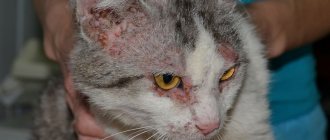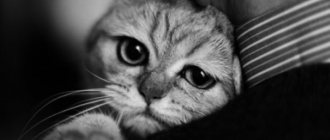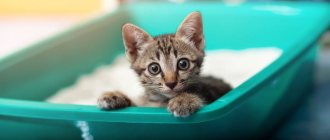Have you noticed that your cat is showing bald spots without any explanation? You may have noticed that your cat is licking certain spots more or is itching or irritated. Maybe your kitten even went potty in an unconventional way. All of these could indicate stress or health problems.
There are quite a few reasons why your cat might have bald spots, and it's best to contact your veterinarian if you notice this. However, it's best to play detective first because the more information you provide your veterinarian, the more likely he is to accurately diagnose and treat your hair loss problem.
So, what causes bald spots on cats?
Fleas
Even the best cat owners can get fleas. Fleas are sneaky and can enter your home through your clothing or other pets. They can hide in carpets and under furniture for months. And fleas can be difficult to get rid of too!
If you notice your cat chewing and itching, it may be due to fleas. Not only are fleas annoying for your cat, but some cats can develop a condition called flea bite dermatitis. This is a type of allergy to the saliva produced by fleas, which causes severe irritation when fleas bite a cat.
© shutterstock
Fleas tend to cluster at the base of cats' tails, which is a sensitive area, so this causes even more irritation. You may notice your cat chewing on the base of its tail, leaving behind bald patches. Fleas can also hang on the face, so the cat may scratch its face frequently, leaving bald patches on the neck and chin.
Fleas can be difficult to spot on cats and they are good at hiding, but there are a few things to watch out for. Fleas and flea bite dermatitis can leave behind red, bumpy skin. Additionally, fleas defecate what is essentially dried blood. If you notice rust-colored spots in your kitty's bowl, they are most likely fleas. If you notice small brown or red flakes on your cat, you can place them on a white piece of paper and drip them on top. If it's flea food, the flakes will melt again and turn into liquid blood.
Causes of hair loss in cats
Dermatophytosis, trichophytosis, lichen
By far the most common disease leading to alopecia is dermatophytosis or lichen. Most often localized on the face and head. In cats, the disease is most often caused by fungi of the genus Microsporum canis. The main symptom is that the hairs fall out on their own and are pulled out very easily, because this is an infection of the hair follicle. Important! With dermatophytosis, itching is not a common symptom! Usually lichen does not itch.
The intensity of manifestation of this disease varies - the lesions can be localized (single) and focal (several) and a generalized form (many areas) with lost hair.
Predisposition to shingles in Persian cats
Persian cats have a breed predisposition to dermatophytosis. They often have chronic recurrent or generalized lichen. In them, this disease is often severe and is somewhat different in form from other breeds. They may also have areas of skin with peeling, but without obvious alopecia. Another form of the disease they have is severe inflammation and the formation of nodules in the skin.
Diagnosis of dermaphytosis
For the diagnosis of dermatophytosis
Previously, fluorescent diagnostics using a Wood's lamp were widely used. However, it has long been proven that this method gives a large amount of error and can only serve for an initial examination. Only some types of mushrooms (about 50%) give the classic apple-green glow. Not everything that glows in a Wood's lamp is ringworm, and vice versa - not everything that glows is ringworm. To confirm the diagnosis, skin scrapings and hair are taken from areas that glowed under a Wood's lamp or from non-luminous but questionable areas and examined under a microscope. If the hair is affected, you can see hair with a destroyed structure, sometimes with fungal spores.
In complex and doubtful cases, the doctor takes the culture into a test tube with a special medium. Unfortunately, the culture takes at least 10 days to prepare, so the doctor will most likely prescribe a trial treatment in this case, because the disease is also dangerous for humans.
Treatment of lichen in cats
If the diagnosis of dermatophytosis
the doctor will prescribe not only local treatments for the affected areas, but also an oral antifungal drug (most often, in cats, this is Itroconazole / Irunin, over a long course. This drug accumulates in the hair itself, preventing the disease from developing. Using only local remedies can lead to a chronic form illness, constant relapses and infection of the apartment with spores.
Remember! Vaccines against lichen (Microderm, Polivak, Vakderm, etc.) are not used in modern veterinary medicine, their effectiveness has not been proven.
IT IS FORBIDDEN!
Some drugs, used the old fashioned way, can do more harm than good! Yam ointment, for example, is simply poisonous to cats! The waste oil, which is still widely used in rural areas, is also poisonous. And treating the affected areas with iodine leads to chemical burns and the hair in such places may not grow back at all.
There are now many modern and safe remedies for the treatment of dermatophytosis, do not self-medicate!
Parasites. Demodecosis.
Demodexes
- These are skin parasites - mites that damage the hair follicle. Previously, it was believed that only dogs suffered from demodicosis, but two types of these mites have also been isolated in cats.
Feline demodicosis
Feline demodicosis is rare. Cats have 2 pathogens - Demodex cati or Demodex gatoi.
Differences between contagious and non-contagious demodicosis:
Demodex gatoi is contagious. Infection and manifestation can occur at any age. The lesions from this mite are itchy and we will see self-induced alopecia.
Demodex cati is not contagious. Normally, they are found in small quantities on the skin of a healthy animal, being opportunistic parasites.
It appears in adult cats; alopecia is spontaneous, that is, areas with fallen hair, without itching. The cause of the manifestation is usually serious immunity disorders - immunosuppression and other serious diseases, for example, diabetes.
The most common cat diseases
Parasites almost always cause itching, and the cat begins to lick and scratch vigorously. Skin lesions and self-induced alopecia appear. The most popular diseases include:
Notoedrosis
Notoedrosis is a lesion with unbearable itching, alopecia, severe scratching and scabs, most often localized on the head and neck.
Cheyletiellosis
Cheyletiellosis - or "wandering dandruff" - looks like flaking skin, there may be hypotrichosis and areas without hair.
Otodectosis
Otodectosis is an ear mite that causes severe itching in the head and alopecia of the ears and muzzle.
lice eaters
Lice eaters are parasites that also cause hair damage and, as a result, hair loss.
Ringworm
Contrary to popular belief, ringworm is not a worm at all. Ringworm is a fungal infection often found in stray and outdoor cats. Ringworm has a characteristic round, scaly rash that appears as a bald spot. It may be red or irritated and may or may not seem to bother your cat.
Most ringworm infections are relatively easy to treat, but before trying any over-the-counter medications, it's best to consult with your veterinarian to make sure your kitten actually has ringworm. By the way, ringworm is contagious to people, and people often get ringworm from their pets.
The main causes of bald spots
Hair loss can be a consequence of seborrhea, a pathology in which the functioning of the sebaceous glands is disrupted.
Firstly, do not confuse baldness with intense shedding. In addition to changing its coat twice a year, the animal may begin to lose hair due to stress, frequent washing, or simply with age. In this case, the loss occurs evenly, without the appearance of bald patches.
Owners should be alert to large areas where there is no hair, the skin is red, small wounds or peeling have appeared. Typically, bald patches appear on the back, neck, behind the ears or on the tail.
Causes of baldness that signal serious disturbances in the functioning of the pet’s body:
- Allergies are the most harmless reason. Allergens may include animal proteins, some types of meat and cereals. It is worth paying attention to changing your pet's diet. It was this that could provoke the onset of allergies and baldness. It is imperative to examine the animal for the presence of parasites - fleas can also cause an allergic reaction.
- Infectious, fungal or parasitic diseases. Some types of fungal infections, such as ringworm, are also dangerous to humans.
- Nervous stress and shock. In this case, alopecia mainly appears on the limbs or abdomen.
- Hormonal disbalance. May be the result of a malfunction of the pancreas, thyroid glands or adrenal glands.
Bald patches can appear locally at the sites of tumors, after injections with medications.
Excessive grooming
When cats are stressed, they may become over-groomed and lose their fur. This stress can be caused by physical illness or changes in the environment, including new pets, moving to a new home, and even changes in food.
Cats are very sensitive to change, so try to make changes slowly. Remember to always provide your kitten with plenty of quiet places to hide, especially if you suspect stress may be related to children or other pets.
Overly groomed cats can shed hair from anywhere, but you will notice that they groom a specific area over and over again until a bald patch remains. Over-grooming is common on feet, and you may notice that your cat is losing a significant amount of hair on her front or back legs. Over-grooming can cause pain in cats, especially joint or bone pain.
If your kitty has arthritis, you may notice hair loss with the development of hot spots, which are shallow wounds created by your cat licking the same spot over and over again. Over time, hot spots can develop into mucous granulomas, which are a thickened area of skin around the hot spot as the body tries to heal the skin. Hot spots and mucous granulomas are not serious but may indicate underlying problems.
If you suspect your cat is over-grooming, assess the environment, make any changes you can make, and consult with your veterinarian to make sure there is no underlying medical problem or need for anxiety medications.
© shutterstock
Non-communicable diseases
The following unfavorable factors of non-contagious etiology lead to the formation of alopecia:
- Unbalanced feeding: in economy class feeds, as well as feed mixtures from natural products, there is not enough building material and biological catalysts for the formation of hairs and maintaining skin health. Therefore, veterinarians recommend using ready-made food of at least premium class. To prepare a feed mixture from natural products, the cat owner needs to acquire the skills of preparing diets. Uncontrolled use of vitamin supplements leads to poisoning and hair loss.
- Allergic reactions: there are allergies to food components, external irritants - pollen, odors, accessories, household items. The fight against the disease consists of eliminating harmful factors. The veterinarian prescribes antihistamines, as well as professional hypoallergenic food.
- Stress: fright, moving, participation in an exhibition, the appearance of a new pet in the apartment. Leads to the loss of a significant part of the coat. Treatment and prevention consists of preventing stressful situations, as well as taking Stop-stress or Vetspokoin medications.
Be sure to read:
What can cause a cat's cheek to swell: causes of swelling and puffiness on the face under the eye
Result of stress
- Hormonal imbalance: congenital or acquired abnormalities are associated primarily with hypothyroidism - insufficient secretion of thyroid hormones. In addition to symmetrical bilateral baldness, cold intolerance, obesity, and hair discoloration occur. The muzzle takes on a pained expression. Treatment consists of lifelong injections of thyroid hormones.
- Congenital pathologies - hypotrichosis and seborrhea. In the first case, babies are born with sparse hair, and by four months they lose the rest of their hair. Pets are constantly cold. No treatment has been developed. Seborrhea is an abnormality of the sebaceous glands. Inflammation develops, in which the hair follicles die along with the sebaceous glands. The most commonly known symptom is the greasy tail. Treatment is symptomatic.
Greasy tail
- Chemical and physical reasons: hair falls out due to unqualified treatment with anti-flea drugs, as well as exposure to overheating when the pet’s rookery is located near functioning heating radiators.
There are situations when a cat sheds all its hair at once for no apparent reason. Possibly, toxic substances enter and accumulate with food, water, and inhaled air.
The body tries to remove toxins from the body in every possible way. First, it directs them to the least valuable parts of the body - hair. When the concentration of toxins reaches a threshold level, hair rejection occurs.
Chemicals
Some chemicals are caustic and can cause burns. If your cat gets into your garage or cleaning chemicals, you may notice hair loss accompanied by painful, rough patches of skin. If you think your cat has been exposed to hazardous chemicals, contact your veterinarian immediately.
Some cats are very sensitive to topical medications, such as flea medications. If your cat begins to lose hair in a manner consistent with how you apply her flea medication, whether in a line along her spine or points on the back of her head and at the base of her tail, she may be reacting to the topical medication. If this happens, talk to your veterinarian about your flea and tick control options. Your cat may be better off on an oral medication or a prescription collar. Always make sure you are purchasing legitimate veterinary flea and tick medications. Cheap supermarket brands are notorious for causing these reactions and much more serious reactions such as seizures. Some online pharmacies sell counterfeit veterinary products, so purchasing directly from a veterinarian is the best way to stay safe.
List of drugs for the treatment of dermatitis in cats
After determining the factor that caused the damage to the skin and coat, the veterinarian may prescribe one of the drugs or a combination:
- Cortavance , Exekan to relieve itching and inflammation.
- Sinulox to eliminate bacterial infection.
- Terbinafine or Lyme sulfur against fungi.
- Shampoo for itching or inflammation. For example, Green Doctor, Globalvet with chlorhexedine.
- Drops on the withers against parasites: Broadline, Inspector, Bravecto.
- Ointments, creams or emulsions, for example Fucidin.
- Vitamins and other nutrients for speedy skin restoration, for example Laveta super or Supercoat.
- Veterinary diet from Royal Canin, Hills, Proplan, Monge or Farmina aimed at improving the quality of coat and dermis.
Watch the video: Veterinarian talks about sores on a cat’s neck
Allergies
Cats can be allergic to certain foods, as well as to foods they previously did well with. Systemic allergies in cats usually result in diffuse hair loss throughout the body.
Food allergies are usually linked to a specific protein, so if you think your cat has developed a food allergy that is causing bald patches, switching to a different protein food and trying it for 6-8 weeks may help. So, if your cat has been eating a chicken-based food, you may want to try a fish-based food. Read labels carefully because some products may find their way into unexpected places.
Some allergies are environmental, such as to grasses, trees, and even other animals such as dogs and people. Your veterinarian can perform allergy tests to determine what exactly your kitten is allergic to.
Rational reasons
Pregnant cats lose hair around their nipples.
The formation of hairless spots in cats is influenced by the following physiological factors:
- Pregnancy and lactation: hairless areas occur mainly around the nipples. The consumption of nutrients and vitamins for the formation of fruits and milk production increases, but there is no longer enough for the coat. The solution is to correct your diet. The best option is to feed ad libitum pelleted food of at least premium class.
- Consequences of frequent bathing with the use of shampoos: the protective layer of hairs of a fat-like nature is destroyed. The hairs die and fall out. Control measures: do not use detergents unless absolutely necessary.
- Complications after injections or burns: scar tissue forms in which there are no hair follicles.
- Old age - hormonal levels change, the absorption of nutrients worsens, which negatively affects the thickness of the coat. The solution is to use specialized food for seniors. The process of hair loss cannot be stopped, but it can be slowed down.
Scabies
Mange can be contagious to other pets or benign and is not common in cats, especially cats that do not roam. If you recently adopted a stray cat, or if your cat went missing and has now returned home and you notice large patches of hair loss, talk to your veterinarian about mange testing.
Whenever you notice your cat losing hair, it is best not to touch it and wash your hands thoroughly whenever you handle the cat or its litter.
The cat has a sore on the neck and hair is falling out: Diagnosis
There are several methods to determine the cause of a cat’s illness:
- Flea feces detection test.
- Studying the cellular composition of the skin using fingerprint smears, scrapings, and tape.
- Scrapings to identify ectoparasite mites .
- Cultures to identify bacteria and fungi.
- Histological examination of the skin.
- Other studies are used less frequently; the decision to prescribe them is made by the doctor. Remember that you have the right to ask the doctor to give you an explanation of why this or that procedure is needed.
Watch the video: Veterinarian advice - Skin diseases in cats and their diagnosis
More serious reasons
Numerous medical conditions can lead to hair loss, including cancer, hyperthyroidism, and protein deficiency. Identifying the underlying cause of bald patches will determine the course of treatment you and your veterinarian choose.
Posted by Christian Adams An American expat living in Metro Manila, Philippines for over a decade, Christian is a lifelong cat lover and the proud father of two rescue cats, Trixie and Chloe. Both girls used to be among the crowds of homeless people who roam the cities and countryside. Three-year-old Trixie was rescued from a litter found under a neighbor's porch, and two-year-old Chloe was brought home by Christian's young son, Henry, who discovered the crying kitten in the parking lot.
Diagnostics
Self-diagnosis and starting to take anti-allergy medications is the worst solution. Only professional diagnostics in a clinic can accurately determine the cause of the symptoms. The fact is that allergies are often disguised as many other diseases that can be triggered. Allergies can also pose a serious threat to the human body, leading to swelling of the larynx and other consequences.
The main method for diagnosing cat allergies is special medical tests. The patient's blood is taken for analysis to detect immunoglobulin E, as well as skin tests.
Why is it not recommended to self-medicate? There are many cases where the cat did not cause the symptoms, although in a sense the animal played a role, which allowed false conclusions to be drawn. The most common options for establishing an erroneous diagnosis:
- an allergic reaction can be caused by accessories and animal care products (litter, cat shampoo, cat food, etc.);
- cats accustomed to walking outside can carry other allergens on their fur (pollen, mold particles, etc.);
- infection from an animal with other diseases with similar symptoms (chlamydia, scabies mites, etc.).
Symptoms
Symptoms that indicate pathological baldness in a cat:
- hair loss in pieces, in large quantities;
- the formation of bald areas behind the ears, on the neck, back, belly and tail;
- change in color of the bald area - it becomes reddened, sometimes covered with wounds, scabs, crusts;
- itching or soreness in the affected area when touched.
If the listed signs are detected, the owner is recommended to immediately take the pet to a veterinary clinic to determine the cause of alopecia and treatment. A wet, bald spot on a cat is a consequence of a bite wound. It heals slowly, becomes covered with ichor, exudate of an unpleasant odor and color. There are other reasons for its appearance: burns, injuries, skin diseases, fungus.











